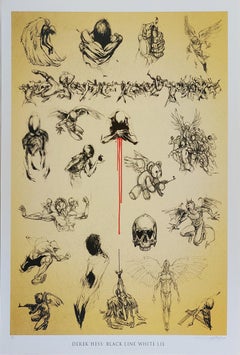Derek Hess
2010s Street Art Prints and Multiples
Paper
A Close Look at street-art Art
Street art is a style created for city walls, subway trains and other public spaces. Sometimes it is commissioned, yet most often it is an individual statement of defiant free expression. Although mostly an urban style, street art can be found all over the world, including JR’s pasted portraits on the separation wall in Palestine, Invader’s playful ceramic tile mosaics in Paris and the provocative stencil and spray-paint works by Banksy in London.
The Philadelphia-based Cornbread — aka Darryl McCray — is considered the first modern graffiti artist. He began tagging his name around the city in the 1960s. Graffiti art later flourished in New York City in the 1970s. There, young artists used spray paint and markers to create tags and large-scale graphic works, with Jean-Michel Basquiat and Keith Haring both developing their distinctive styles through the graffiti scene, which would evolve into street art. Artists such as Tracy 168 and Lady Pink pioneered the Wild Style of complex graffiti writing in the 1980s, pushing the movement forward.
Because of its unsanctioned, improvisational and frequently covert nature, street art involves a range of techniques and aesthetics. Some street artists use quick and effective stenciling, whereas others wheat-paste posters, commandeer video projectors or freehand draw elaborate illustrations and murals. Shepard Fairey made his mark with street art stickers before designing the iconic “Hope” poster for Barack Obama’s 2008 presidential campaign.
While the origins of street art are rooted in a strictly noncommercial creative act that confronted political issues, sexuality and more for a general audience of passersby, the art form has moved inside the galleries over the years. Today, just as Basquiat and Haring took their works from Manhattan’s Lower East Side alleyways into Soho galleries, artists including KAWS, Barry McGee and Osgemeos are in demand with collectors of fine art.
Find a collection of street art paintings, sculptures, prints and multiples and more on 1stDibs.
Finding the Right prints-works-on-paper for You
Decorating with fine art prints — whether they’re figurative prints, abstract prints or another variety — has always been a practical way of bringing a space to life as well as bringing works by an artist you love into your home.
Pursued in the 1960s and ’70s, largely by Pop artists drawn to its associations with mass production, advertising, packaging and seriality, as well as those challenging the primacy of the Abstract Expressionist brushstroke, printmaking was embraced in the 1980s by painters and conceptual artists ranging from David Salle and Elizabeth Murray to Adrian Piper and Sherrie Levine.
Printmaking is the transfer of an image from one surface to another. An artist takes a material like stone, metal, wood or wax, carves, incises, draws or otherwise marks it with an image, inks or paints it and then transfers the image to a piece of paper or other material.
Fine art prints are frequently confused with their more commercial counterparts. After all, our closest connection to the printed image is through mass-produced newspapers, magazines and books, and many people don’t realize that even though prints are editions, they start with an original image created by an artist with the intent of reproducing it in a small batch. Fine art prints are created in strictly limited editions — 20 or 30 or maybe 50 — and are always based on an image created specifically to be made into an edition.
Many people think of revered Dutch artist Rembrandt as a painter but may not know that he was a printmaker as well. His prints have been preserved in time along with the work of other celebrated printmakers such as Pablo Picasso, Salvador Dalí and Andy Warhol. These fine art prints are still highly sought after by collectors.
“It’s another tool in the artist’s toolbox, just like painting or sculpture or anything else that an artist uses in the service of mark making or expressing him- or herself,” says International Fine Print Dealers Association (IFPDA) vice president Betsy Senior, of New York’s Betsy Senior Fine Art, Inc.
Because artist’s editions tend to be more affordable and available than his or her unique works, they’re more accessible and can be a great opportunity to bring a variety of colors, textures and shapes into a space.
For tight corners, select small fine art prints as opposed to the oversized bold piece you’ll hang as a focal point in the dining area. But be careful not to choose something that is too big for your space. And feel free to lean into it if need be — not every work needs picture-hanging hooks. Leaning a larger fine art print against the wall behind a bookcase can add a stylish installation-type dynamic to your living room. (Read more about how to arrange wall art here.)
Find fine art prints for sale on 1stDibs today.
